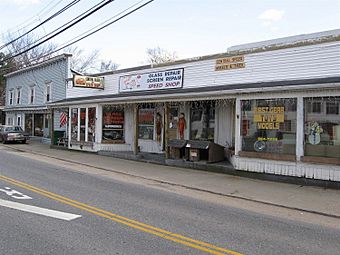Central Village Historic District facts for kids
Quick facts for kids |
|
|
Central Village Historic District
|
|

Shops in the center of Plainfield
|
|
| Location | Roughly, School, Main and Water Sts., and Putnam Rd. N to Plainfield High School, Plainfield, Connecticut |
|---|---|
| Area | 130 acres (53 ha) |
| Architect | Plainfield Woolen Company |
| Architectural style | Bungalow/Craftsman, Greek Revival, Italianate |
| NRHP reference No. | 91000949 |
| Added to NRHP | August 9, 1991 |
The Central Village Historic District is a special area in Plainfield, Connecticut. It's called a historic district because it has many old and important buildings. This district was added to the National Register of Historic Places (NRHP) in 1991.
This area shows what a mill village looked like in the late 1800s. A mill village was a town built around factories, often textile mills. The district includes a small shopping area where two main roads, Connecticut Route 12 and Route 14, meet. You can also see fancy houses built by the mill owners and managers. Plus, there are many homes where the mill workers used to live.
What Makes Central Village Special?
The district includes the Plainfield Woolen Company Mill. This mill is so important that it has its own separate listing on the National Register. You can also find old parts of other mill buildings that are now just ruins.
Other important buildings in the district are:
- Plainfield's old town hall, built in 1872.
- Plainfield High School, built in 1924.
- The beautiful Italianate mansion of mill owner Arthur Fenner, built around 1855.
- The Greek Revival Congregational Church, built in 1845.
These buildings show different styles of architecture from the past.
A Look Back at History
Before 1814, Central Village was mostly farmland. But then, a group of local people decided to build a small cotton mill. They built it next to the Moosup River. This mill grew over time, and the owners built houses for the workers. This is how the small village started to form.
In 1845, the Central Manufacturing Company, which was the biggest employer in the village, built a large brick mill. The village grew even more when the railroad arrived in 1839. The train tracks ran right between two mill locations, making it easier to transport goods and people.
The cotton mills faced challenges in the late 1800s. But other businesses helped the local economy stay strong. In the early 1900s, the Plainfield Woolen Company brought the textile industry back to life. They built the main mill building that you can still see today.



